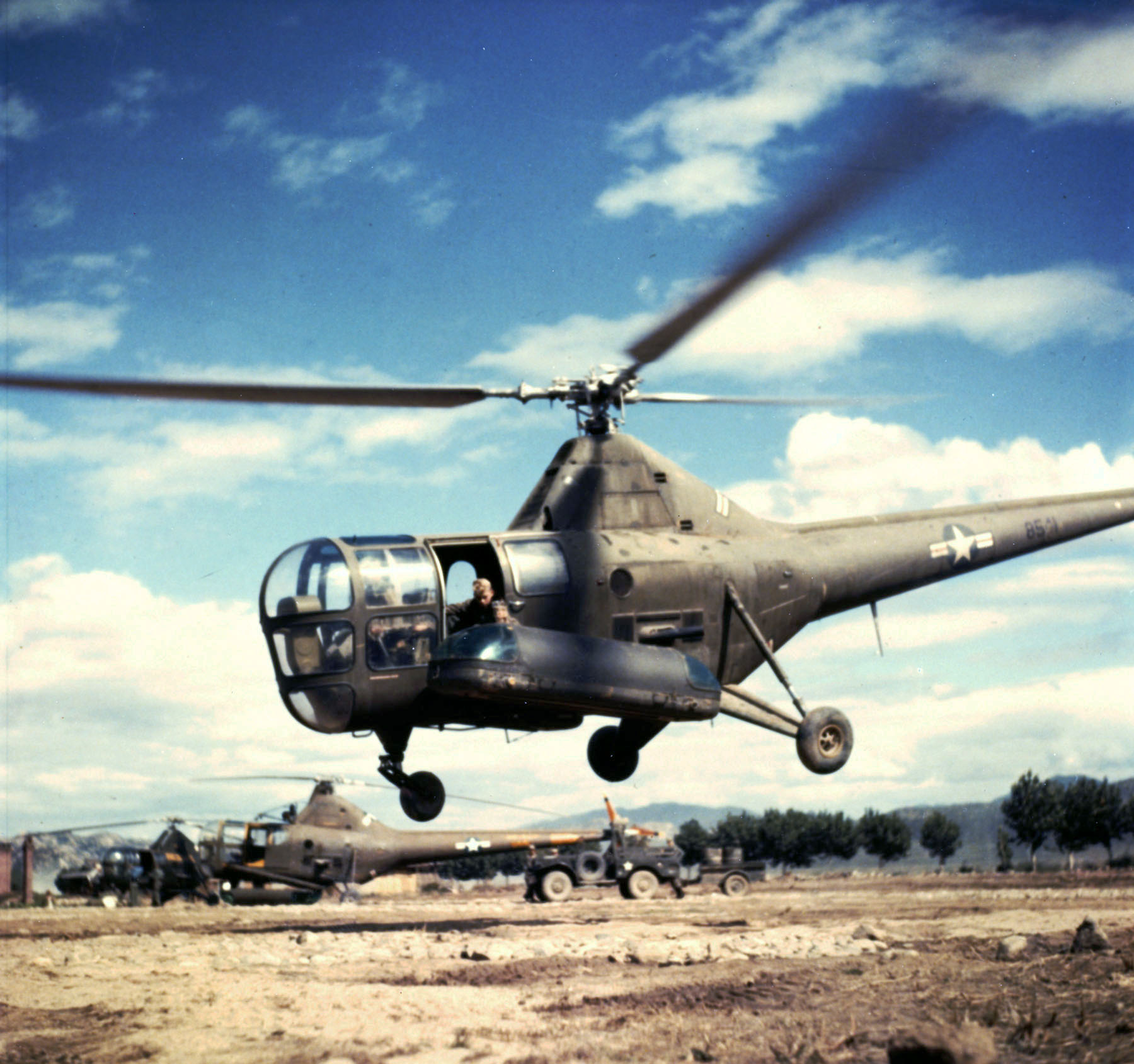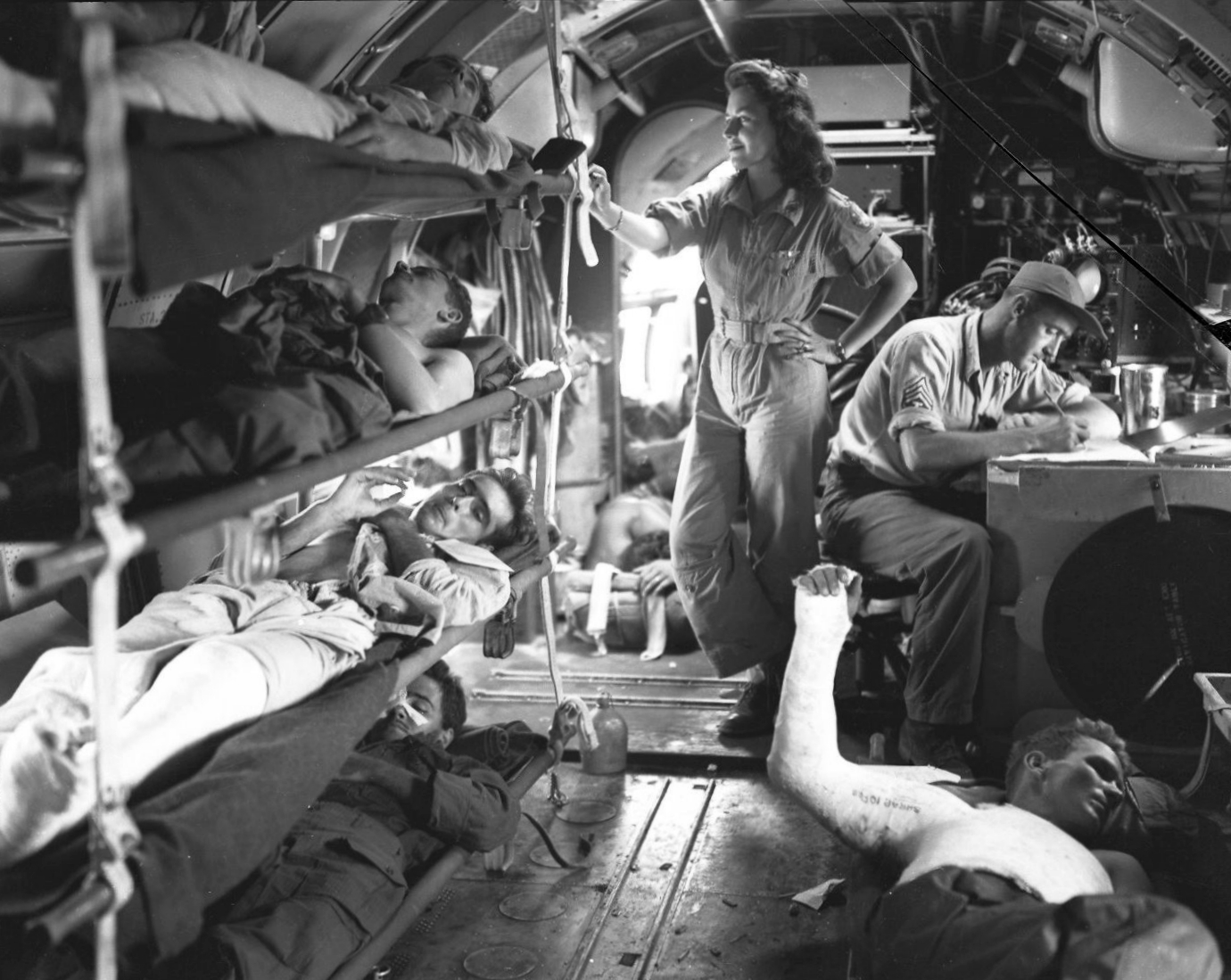|
Aeromedical Evacuation
Aeromedical evacuation (AE) is the use of military transport aircraft to carry wounded personnel. The first recorded British ambulance flight took place in 1917 in the Sinai Peninsula some 30 miles south of El Arish when a Royal Aircraft Factory B.E.2c flew out a soldier in the Imperial Camel Corps who had been shot in the ankle during the raid on Bir el Hassana. The flight took 45 minutes; the same journey by land would have taken some 3 days. In the 1920s several aeromedical services, both official and unofficial, started up in various parts of the world. Aircraft were still primitive at the time, with limited capabilities, and the efforts received mixed reviews. Development of the idea continued. France and the United Kingdom used fully organized aeromedical evacuation services during the African and Middle Eastern colonial wars of the 1920s. In 1920, the British, while suppressing the " Mad Mullah" in Somaliland, used an Airco DH.9A fitted out as an air ambulance ... [...More Info...] [...Related Items...] OR: [Wikipedia] [Google] [Baidu] |
Medevac Mission, Balad Air Base, Iraq
Medical evacuation, often shortened to medevac or medivac, is the timely and efficient movement and en route care provided by medical personnel to patients requiring evacuation or transport using medically equipped air ambulances, helicopters and other means of emergency transport including ground ambulance and maritime transfers. Examples include civilian Emergency medical services, EMS vehicles, civilian aeromedical helicopter services, and military air ambulances. This term also covers the transfer of patients from the battlefield to a treatment facility or from one treatment facility to another by medical personnel, such as from a local hospital to another medical facility which has adequate medical equipment. In Asia, according to Aeromedical Global (M) Sdn Bhd, medical evacuations via air ambulance can be performed via a single or dual stretched setup. According to patients medical condition, Emergency Air Ambulances will be equipped with relevant equipment (ventilators, ... [...More Info...] [...Related Items...] OR: [Wikipedia] [Google] [Baidu] |
Douglas C-47 Skytrain
The Douglas C-47 Skytrain or Dakota ( RAF designation) is a military transport aircraft developed from the civilian Douglas DC-3 airliner. It was used extensively by the Allies during World War II. During the war the C-47 was used for troop transport, cargo, paratrooper, for towing gliders and military cargo parachute drops. The C-47 remained in front-line service with various military operators for many years.Parker 2013, pp. 13, 35, 37, 39, 45–47. It was produced in approximately triple the numbers as the larger, much heavier payload Curtiss C-46 Commando, which filled a similar role for the U.S. military. Approximately 100 countries' armed forces have operated the C-47 with over 60 variants of the aircraft produced. As with the civilian DC-3, the C-47 remains in service, over 80 years after the type's introduction. Design and development The C-47 differed from the civilian DC-3 by way of numerous modifications, including being fitted with a cargo door, hoist attac ... [...More Info...] [...Related Items...] OR: [Wikipedia] [Google] [Baidu] |
Curtiss C-46 Commando
The Curtiss C-46 Commando is a low-wing, twin-engine aircraft derived from the Curtiss CW-20 pressurized high-altitude airliner design. Early press reports used the name "Condor III" but the Commando name was in use by early 1942 in company publicity. It was used primarily as a cargo aircraft during World War II, with fold-down seating for military transport and some use in delivering paratroops. Mainly deployed by the United States Army Air Forces, it also served the U.S. Navy/ Marine Corps, which called it R5C. The C-46 filled similar roles as its Douglas-built counterpart, the C-47 Skytrain, with some 3,200 C-46s produced to approximately 10,200 C-47s. After World War II, a few surplus C-46 aircraft were briefly used in their original role as passenger airliners but the glut of surplus C-47s dominated the marketplace and the C-46 was soon relegated to cargo duty. The type continued in U.S. Air Force service in a secondary role until 1968. The C-46 continues in operation as ... [...More Info...] [...Related Items...] OR: [Wikipedia] [Google] [Baidu] |
Aeromedical
Air medical services are the use of aircraft, including both fixed-wing aircraft and helicopters to provide various kinds of urgent medical care, especially prehospital, emergency and critical care to patients during aeromedical evacuation and rescue operations. History During World War I, air transport was used to provide medical evacuation – either from frontline areas or the battlefield itself. In 1928, in Australia, John Flynn founded the Flying Doctor Service (later the Royal Flying Doctor Service), to provide a wide range of medical services to civilians in remote areas; these included from routine consultations with travelling general practitioners, to air ambulance evacuations and other emergency medical services. Fixed wing military air ambulances came into regular use during World War II. Helicopters became more commonly used for such purposes during the Korean and Vietnam wars. Later, helicopters were introduced to civilian health care, especially for short ... [...More Info...] [...Related Items...] OR: [Wikipedia] [Google] [Baidu] |
Douglas C-1
The Douglas C-1 was a cargo/transport aircraft produced by the Douglas Aircraft Corporation for the United States Army Air Service starting in 1925. Design and development Douglas received an order for nine single-engined transport aircraft in 1925, the first aircraft flying from Douglas's Santa Monica, California factory on 2 May 1925.Francillon 1979, p. 96. The C-1 was the first aircraft assigned in the new C- category. The aircraft design was based on several earlier and similar designs developed by Douglas in the early 1920s (including the Douglas World Cruisers used in the first round-the-world flight in 1924). The C-1 featured an enclosed passenger compartment capable of carrying six passengers or about 2,500 lb (1,100 kg) of cargo. A trap door was placed in the lower fuselage to allow large and/or heavy cargo (particularly aircraft engines) to be lifted directly into the cargo compartment. An auxiliary door for passengers and light cargo was included on the right ... [...More Info...] [...Related Items...] OR: [Wikipedia] [Google] [Baidu] |
Curtiss Eagle
The Curtiss Eagle (retroactively designated the Model 19 by Curtiss some years later) was an airliner produced in small numbers in the United States shortly after World War I. The aircraft was a conventional biplane with three-bay, unstaggered wings of equal span. The fuselage was a very advanced design for its day, incorporating careful streamlining of its monocoque structure, and offering the crew as well as the passengers a fully enclosed cabin. The Eagle is sometimes named as the first American tri-motor aircraft; however Curtiss' own Model H flying boat flew with three engines for a time in 1914 before being converted back to twin-engine configuration. Development Curtiss had developed the Eagle in preparation for an anticipated post-war boom in civil aviation. In fact, this boom was far smaller than Curtiss had been hoping for, and practically all of the demand for passenger aircraft was met by the conversion of war-surplus military aircraft that could be purchased extremel ... [...More Info...] [...Related Items...] OR: [Wikipedia] [Google] [Baidu] |
Litter (rescue Basket)
A litter is a stretcher designed to be used where there are physical obstacles that impair movement, including other hazards such as, in confined spaces, on slopes or uneven terrain, or in densely forested areas. Typically it is shaped to accommodate an adult in a supine position, face up position and it is used in search and rescue operations. The person is strapped into the basket, making safe evacuation possible. The person generally is further protected by a cervical collar and sometimes a long spine board, so as to immobilize the person and prevent further injury. A litter essentially is a stretcher with sides (or just a raised edge) and a removable head and/or torso cover. They are most notably remembered from Korean War, Korea and Vietnam War, Vietnam images of United States Air Force Pararescue airmen or more recent United States Coast Guard, Coast Guard video clips of Helicopter rescue basket, helicopters rescuing injured people from isolated areas. Some will also recall ... [...More Info...] [...Related Items...] OR: [Wikipedia] [Google] [Baidu] |
Curtiss JN-4
The Curtiss JN "Jenny" is a series of biplanes built by the Glenn Curtiss Aeroplane Company of Hammondsport, New York, later the Curtiss Aeroplane and Motor Company. Although the Curtiss JN series was originally produced as a training aircraft for the US Army, the "Jenny" (the common nickname derived from "JN") continued after World War I as a civilian aircraft, becoming the "backbone of American postwar ivilaviation". Thousands of surplus Jennys were sold at bargain prices to private owners in the years after the war, and became central to the barnstorming era that helped awaken the US to civil aviation through much of the 1920s. Design and development Curtiss combined the best features of the model J and model N trainers, built for the US Army and US Navy, and began producing the JN or "Jenny" series of aircraft in 1915. Curtiss built only a limited number of the JN-1 and JN-2 biplanes. The design was commissioned by Glenn Curtiss from Englishman Benjamin Douglas Thom ... [...More Info...] [...Related Items...] OR: [Wikipedia] [Google] [Baidu] |
Korean War
The Korean War (25 June 1950 – 27 July 1953) was an armed conflict on the Korean Peninsula fought between North Korea (Democratic People's Republic of Korea; DPRK) and South Korea (Republic of Korea; ROK) and their allies. North Korea was supported by China and the Soviet Union, while South Korea was supported by the United Nations Command (UNC) led by the United States. The conflict was one of the first major proxy wars of the Cold War. Fighting ended in 1953 with an armistice but no peace treaty, leading to the ongoing Korean conflict. After the end of World War II in 1945, Korea, which had been a Korea under Japanese rule, Japanese colony for 35 years, was Division of Korea, divided by the Soviet Union and the United States into two occupation zones at the 38th parallel north, 38th parallel, with plans for a future independent state. Due to political disagreements and influence from their backers, the zones formed their governments in 1948. North Korea was led by Kim Il S ... [...More Info...] [...Related Items...] OR: [Wikipedia] [Google] [Baidu] |







